warning light CHEVROLET KODIAK 2005 Owner's Guide
[x] Cancel search | Manufacturer: CHEVROLET, Model Year: 2005, Model line: KODIAK, Model: CHEVROLET KODIAK 2005Pages: 374, PDF Size: 5.46 MB
Page 250 of 374
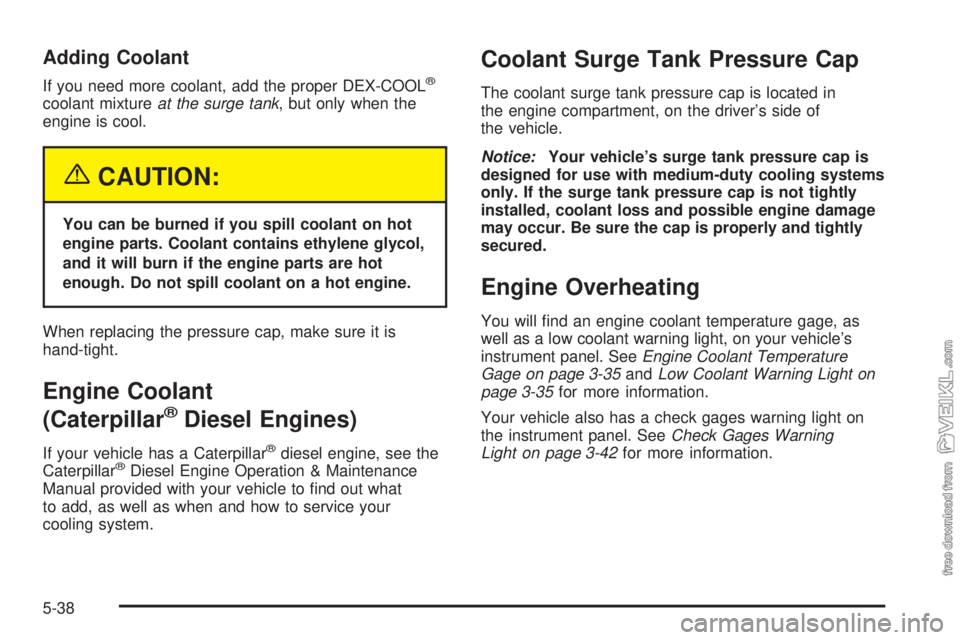
Adding Coolant
If you need more coolant, add the proper DEX-COOL®
coolant mixtureat the surge tank, but only when the
engine is cool.
{CAUTION:
You can be burned if you spill coolant on hot
engine parts. Coolant contains ethylene glycol,
and it will burn if the engine parts are hot
enough. Do not spill coolant on a hot engine.
When replacing the pressure cap, make sure it is
hand-tight.
Engine Coolant
(Caterpillar
®Diesel Engines)
If your vehicle has a Caterpillar®diesel engine, see the
Caterpillar®Diesel Engine Operation & Maintenance
Manual provided with your vehicle to find out what
to add, as well as when and how to service your
cooling system.
Coolant Surge Tank Pressure Cap
The coolant surge tank pressure cap is located in
the engine compartment, on the driver’s side of
the vehicle.
Notice:Your vehicle’s surge tank pressure cap is
designed for use with medium-duty cooling systems
only. If the surge tank pressure cap is not tightly
installed, coolant loss and possible engine damage
may occur. Be sure the cap is properly and tightly
secured.
Engine Overheating
You will find an engine coolant temperature gage, as
well as a low coolant warning light, on your vehicle’s
instrument panel. SeeEngine Coolant Temperature
Gage on page 3-35andLow Coolant Warning Light on
page 3-35for more information.
Your vehicle also has a check gages warning light on
the instrument panel. SeeCheck Gages Warning
Light on page 3-42for more information.
5-38
Page 251 of 374
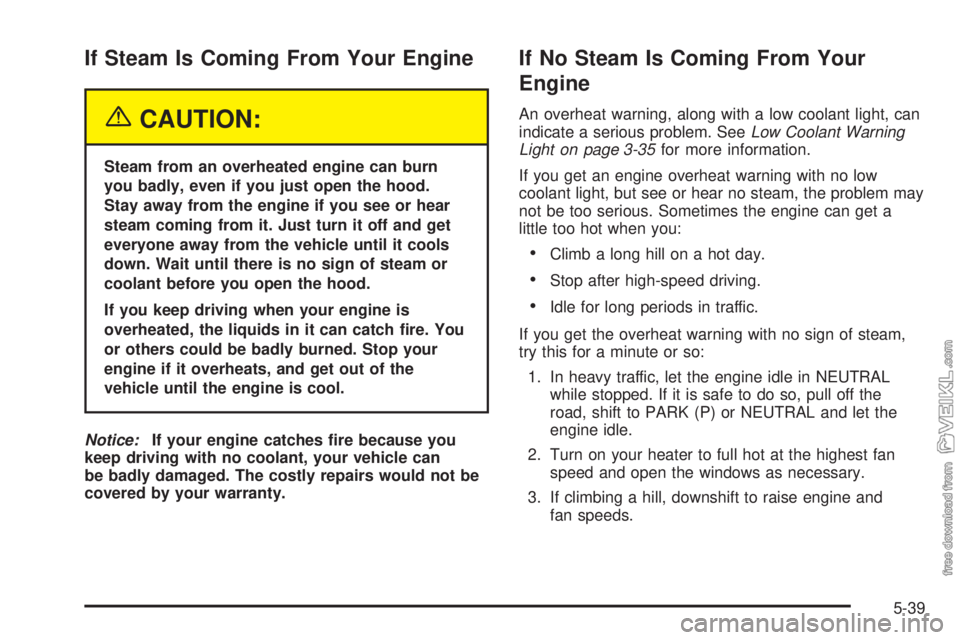
If Steam Is Coming From Your Engine
{CAUTION:
Steam from an overheated engine can burn
you badly, even if you just open the hood.
Stay away from the engine if you see or hear
steam coming from it. Just turn it off and get
everyone away from the vehicle until it cools
down. Wait until there is no sign of steam or
coolant before you open the hood.
If you keep driving when your engine is
overheated, the liquids in it can catch �re. You
or others could be badly burned. Stop your
engine if it overheats, and get out of the
vehicle until the engine is cool.
Notice:If your engine catches �re because you
keep driving with no coolant, your vehicle can
be badly damaged. The costly repairs would not be
covered by your warranty.
If No Steam Is Coming From Your
Engine
An overheat warning, along with a low coolant light, can
indicate a serious problem. SeeLow Coolant Warning
Light on page 3-35for more information.
If you get an engine overheat warning with no low
coolant light, but see or hear no steam, the problem may
not be too serious. Sometimes the engine can get a
little too hot when you:
•Climb a long hill on a hot day.
•Stop after high-speed driving.
•Idle for long periods in traffic.
If you get the overheat warning with no sign of steam,
try this for a minute or so:
1. In heavy traffic, let the engine idle in NEUTRAL
while stopped. If it is safe to do so, pull off the
road, shift to PARK (P) or NEUTRAL and let the
engine idle.
2. Turn on your heater to full hot at the highest fan
speed and open the windows as necessary.
3. If climbing a hill, downshift to raise engine and
fan speeds.
5-39
Page 257 of 374
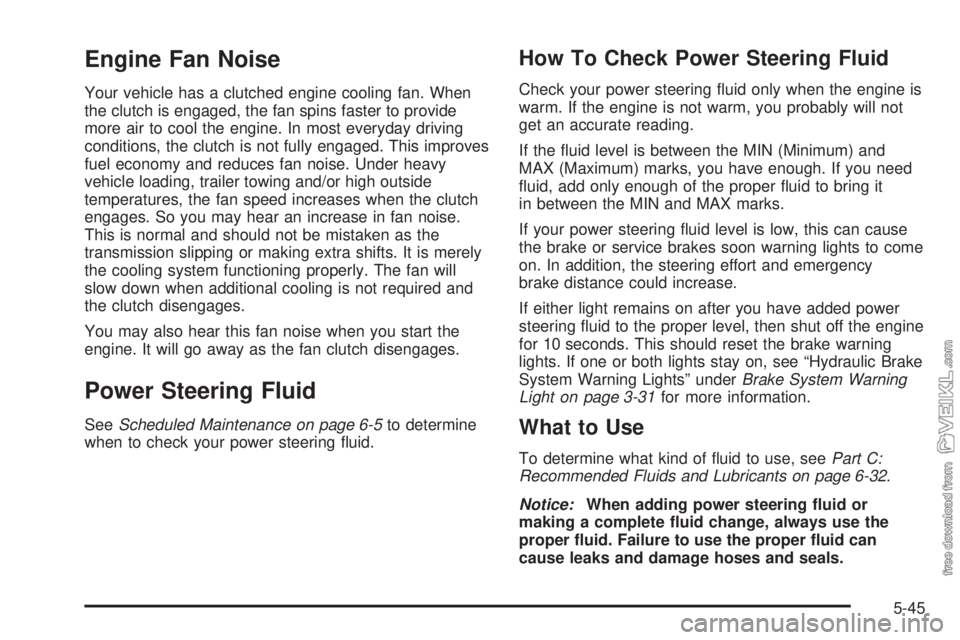
Engine Fan Noise
Your vehicle has a clutched engine cooling fan. When
the clutch is engaged, the fan spins faster to provide
more air to cool the engine. In most everyday driving
conditions, the clutch is not fully engaged. This improves
fuel economy and reduces fan noise. Under heavy
vehicle loading, trailer towing and/or high outside
temperatures, the fan speed increases when the clutch
engages. So you may hear an increase in fan noise.
This is normal and should not be mistaken as the
transmission slipping or making extra shifts. It is merely
the cooling system functioning properly. The fan will
slow down when additional cooling is not required and
the clutch disengages.
You may also hear this fan noise when you start the
engine. It will go away as the fan clutch disengages.
Power Steering Fluid
SeeScheduled Maintenance on page 6-5to determine
when to check your power steering fluid.
How To Check Power Steering Fluid
Check your power steering fluid only when the engine is
warm. If the engine is not warm, you probably will not
get an accurate reading.
If the fluid level is between the MIN (Minimum) and
MAX (Maximum) marks, you have enough. If you need
fluid, add only enough of the proper fluid to bring it
in between the MIN and MAX marks.
If your power steering fluid level is low, this can cause
the brake or service brakes soon warning lights to come
on. In addition, the steering effort and emergency
brake distance could increase.
If either light remains on after you have added power
steering fluid to the proper level, then shut off the engine
for 10 seconds. This should reset the brake warning
lights. If one or both lights stay on, see “Hydraulic Brake
System Warning Lights” underBrake System Warning
Light on page 3-31for more information.
What to Use
To determine what kind of fluid to use, seePart C:
Recommended Fluids and Lubricants on page 6-32.
Notice:When adding power steering �uid or
making a complete �uid change, always use the
proper �uid. Failure to use the proper �uid can
cause leaks and damage hoses and seals.
5-45
Page 302 of 374
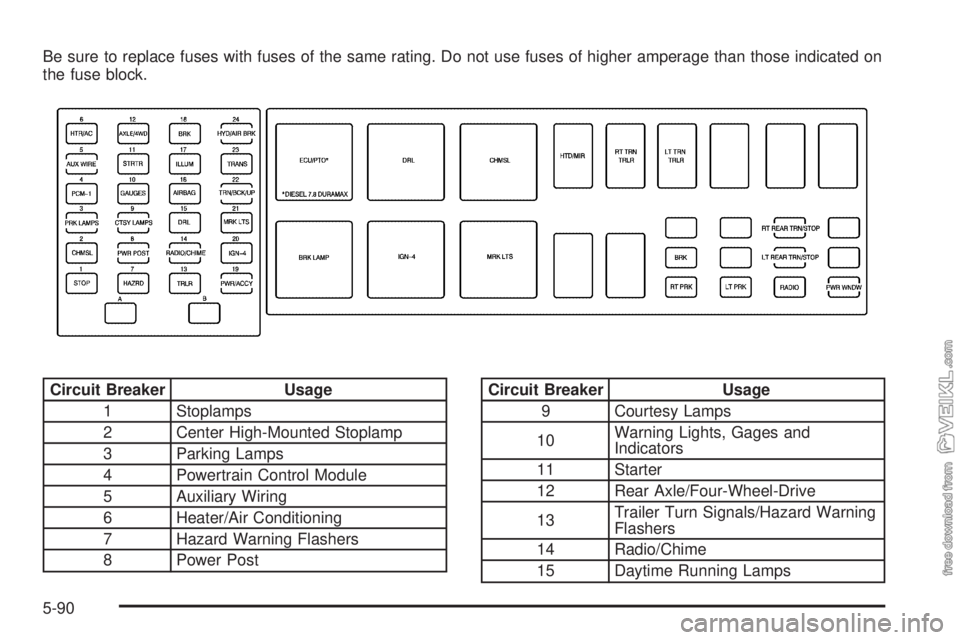
Be sure to replace fuses with fuses of the same rating. Do not use fuses of higher amperage than those indicated on
the fuse block.
Circuit Breaker Usage
1 Stoplamps
2 Center High-Mounted Stoplamp
3 Parking Lamps
4 Powertrain Control Module
5 Auxiliary Wiring
6 Heater/Air Conditioning
7 Hazard Warning Flashers
8 Power PostCircuit Breaker Usage
9 Courtesy Lamps
10Warning Lights, Gages and
Indicators
11 Starter
12 Rear Axle/Four-Wheel-Drive
13Trailer Turn Signals/Hazard Warning
Flashers
14 Radio/Chime
15 Daytime Running Lamps
5-90
Page 306 of 374
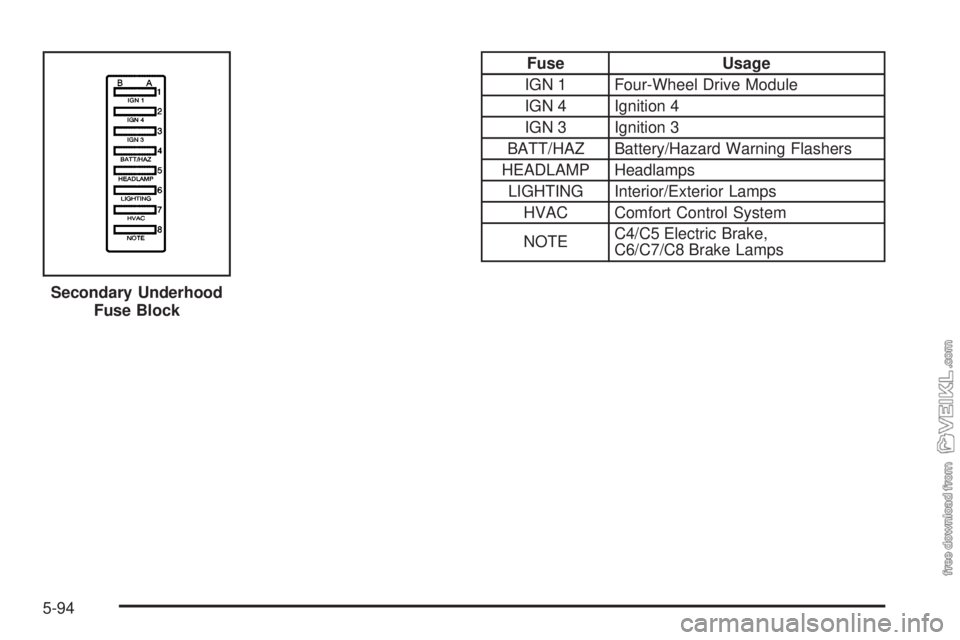
Fuse Usage
IGN 1 Four-Wheel Drive Module
IGN 4 Ignition 4
IGN 3 Ignition 3
BATT/HAZ Battery/Hazard Warning Flashers
HEADLAMP Headlamps
LIGHTING Interior/Exterior Lamps
HVAC Comfort Control System
NOTEC4/C5 Electric Brake,
C6/C7/C8 Brake Lamps
Secondary Underhood
Fuse Block
5-94
Page 344 of 374
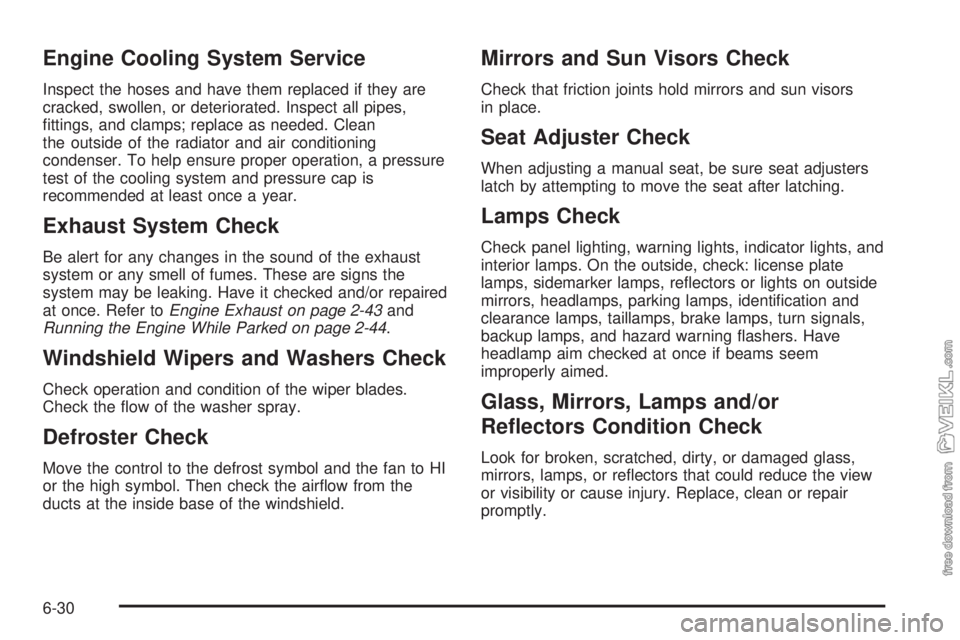
Engine Cooling System Service
Inspect the hoses and have them replaced if they are
cracked, swollen, or deteriorated. Inspect all pipes,
fittings, and clamps; replace as needed. Clean
the outside of the radiator and air conditioning
condenser. To help ensure proper operation, a pressure
test of the cooling system and pressure cap is
recommended at least once a year.
Exhaust System Check
Be alert for any changes in the sound of the exhaust
system or any smell of fumes. These are signs the
system may be leaking. Have it checked and/or repaired
at once. Refer toEngine Exhaust on page 2-43and
Running the Engine While Parked on page 2-44.
Windshield Wipers and Washers Check
Check operation and condition of the wiper blades.
Check the flow of the washer spray.
Defroster Check
Move the control to the defrost symbol and the fan to HI
or the high symbol. Then check the airflow from the
ducts at the inside base of the windshield.
Mirrors and Sun Visors Check
Check that friction joints hold mirrors and sun visors
in place.
Seat Adjuster Check
When adjusting a manual seat, be sure seat adjusters
latch by attempting to move the seat after latching.
Lamps Check
Check panel lighting, warning lights, indicator lights, and
interior lamps. On the outside, check: license plate
lamps, sidemarker lamps, reflectors or lights on outside
mirrors, headlamps, parking lamps, identification and
clearance lamps, taillamps, brake lamps, turn signals,
backup lamps, and hazard warning flashers. Have
headlamp aim checked at once if beams seem
improperly aimed.
Glass, Mirrors, Lamps and/or
Re�ectors Condition Check
Look for broken, scratched, dirty, or damaged glass,
mirrors, lamps, or reflectors that could reduce the view
or visibility or cause injury. Replace, clean or repair
promptly.
6-30
Page 361 of 374
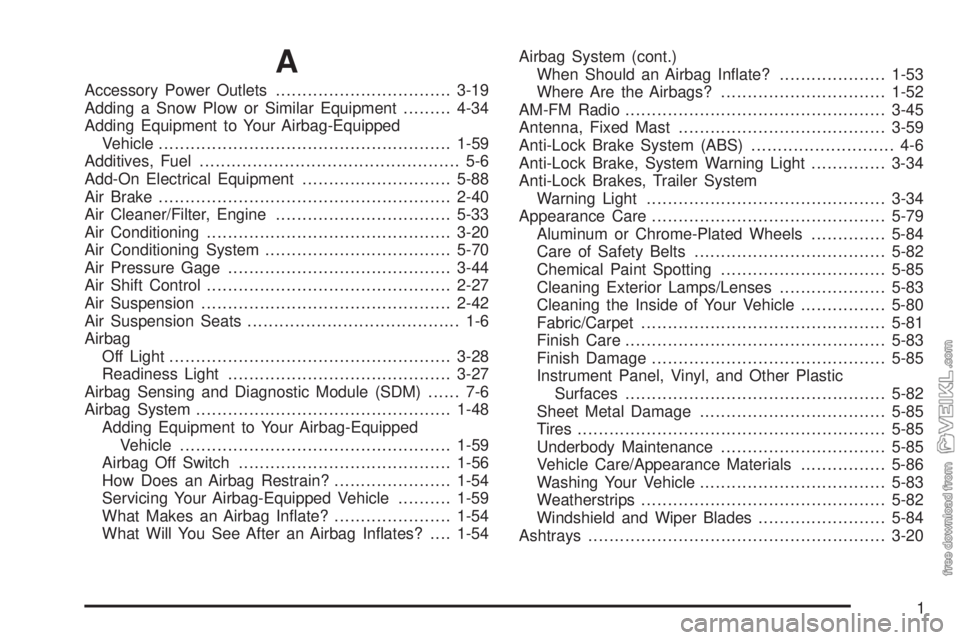
A
Accessory Power Outlets.................................3-19
Adding a Snow Plow or Similar Equipment.........4-34
Adding Equipment to Your Airbag-Equipped
Vehicle.......................................................1-59
Additives, Fuel................................................. 5-6
Add-On Electrical Equipment............................5-88
Air Brake.......................................................2-40
Air Cleaner/Filter, Engine.................................5-33
Air Conditioning..............................................3-20
Air Conditioning System...................................5-70
Air Pressure Gage..........................................3-44
Air Shift Control..............................................2-27
Air Suspension...............................................2-42
Air Suspension Seats........................................ 1-6
Airbag
Off Light.....................................................3-28
Readiness Light..........................................3-27
Airbag Sensing and Diagnostic Module (SDM)...... 7-6
Airbag System................................................1-48
Adding Equipment to Your Airbag-Equipped
Vehicle...................................................1-59
Airbag Off Switch........................................1-56
How Does an Airbag Restrain?......................1-54
Servicing Your Airbag-Equipped Vehicle..........1-59
What Makes an Airbag Inflate?......................1-54
What Will You See After an Airbag Inflates?....1-54Airbag System (cont.)
When Should an Airbag Inflate?....................1-53
Where Are the Airbags?...............................1-52
AM-FM Radio.................................................3-45
Antenna, Fixed Mast.......................................3-59
Anti-Lock Brake System (ABS)........................... 4-6
Anti-Lock Brake, System Warning Light..............3-34
Anti-Lock Brakes, Trailer System
Warning Light.............................................3-34
Appearance Care............................................5-79
Aluminum or Chrome-Plated Wheels..............5-84
Care of Safety Belts....................................5-82
Chemical Paint Spotting...............................5-85
Cleaning Exterior Lamps/Lenses....................5-83
Cleaning the Inside of Your Vehicle................5-80
Fabric/Carpet..............................................5-81
Finish Care.................................................5-83
Finish Damage............................................5-85
Instrument Panel, Vinyl, and Other Plastic
Surfaces.................................................5-82
Sheet Metal Damage...................................5-85
Tires..........................................................5-85
Underbody Maintenance...............................5-85
Vehicle Care/Appearance Materials................5-86
Washing Your Vehicle...................................5-83
Weatherstrips..............................................5-82
Windshield and Wiper Blades........................5-84
Ashtrays........................................................3-20
1
Page 362 of 374
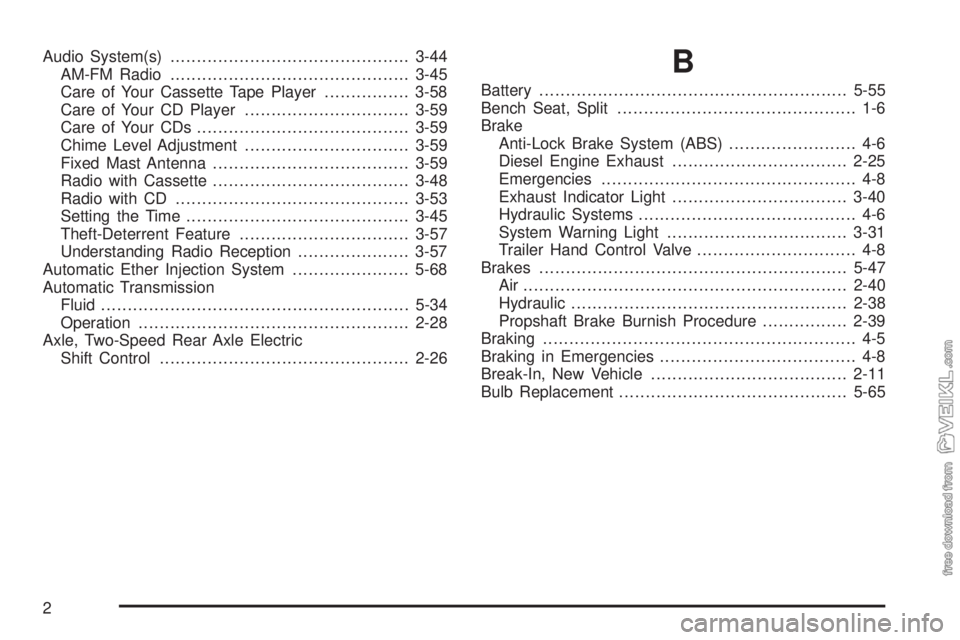
Audio System(s).............................................3-44
AM-FM Radio.............................................3-45
Care of Your Cassette Tape Player................3-58
Care of Your CD Player...............................3-59
Care of Your CDs........................................3-59
Chime Level Adjustment...............................3-59
Fixed Mast Antenna.....................................3-59
Radio with Cassette.....................................3-48
Radio with CD............................................3-53
Setting the Time..........................................3-45
Theft-Deterrent Feature................................3-57
Understanding Radio Reception.....................3-57
Automatic Ether Injection System......................5-68
Automatic Transmission
Fluid..........................................................5-34
Operation...................................................2-28
Axle, Two-Speed Rear Axle Electric
Shift Control...............................................2-26B
Battery..........................................................5-55
Bench Seat, Split............................................. 1-6
Brake
Anti-Lock Brake System (ABS)........................ 4-6
Diesel Engine Exhaust.................................2-25
Emergencies................................................ 4-8
Exhaust Indicator Light.................................3-40
Hydraulic Systems......................................... 4-6
System Warning Light..................................3-31
Trailer Hand Control Valve.............................. 4-8
Brakes..........................................................5-47
Air .............................................................2-40
Hydraulic....................................................2-38
Propshaft Brake Burnish Procedure................2-39
Braking........................................................... 4-5
Braking in Emergencies..................................... 4-8
Break-In, New Vehicle.....................................2-11
Bulb Replacement...........................................5-65
2
Page 363 of 374
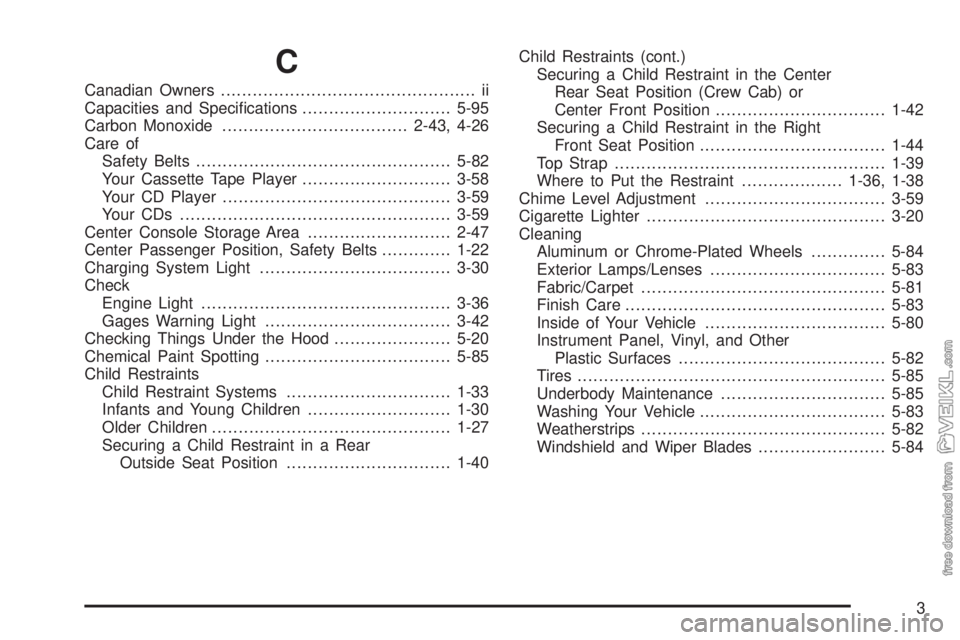
C
Canadian Owners................................................ ii
Capacities and Specifications............................5-95
Carbon Monoxide...................................2-43, 4-26
Care of
Safety Belts................................................5-82
Your Cassette Tape Player............................3-58
Your CD Player...........................................3-59
Your CDs ...................................................3-59
Center Console Storage Area...........................2-47
Center Passenger Position, Safety Belts.............1-22
Charging System Light....................................3-30
Check
Engine Light...............................................3-36
Gages Warning Light...................................3-42
Checking Things Under the Hood......................5-20
Chemical Paint Spotting...................................5-85
Child Restraints
Child Restraint Systems...............................1-33
Infants and Young Children...........................1-30
Older Children.............................................1-27
Securing a Child Restraint in a Rear
Outside Seat Position...............................1-40Child Restraints (cont.)
Securing a Child Restraint in the Center
Rear Seat Position (Crew Cab) or
Center Front Position................................1-42
Securing a Child Restraint in the Right
Front Seat Position...................................1-44
Top Strap...................................................1-39
Where to Put the Restraint...................1-36, 1-38
Chime Level Adjustment..................................3-59
Cigarette Lighter.............................................3-20
Cleaning
Aluminum or Chrome-Plated Wheels..............5-84
Exterior Lamps/Lenses.................................5-83
Fabric/Carpet..............................................5-81
Finish Care.................................................5-83
Inside of Your Vehicle..................................5-80
Instrument Panel, Vinyl, and Other
Plastic Surfaces.......................................5-82
Tires..........................................................5-85
Underbody Maintenance...............................5-85
Washing Your Vehicle...................................5-83
Weatherstrips..............................................5-82
Windshield and Wiper Blades........................5-84
3
Page 364 of 374
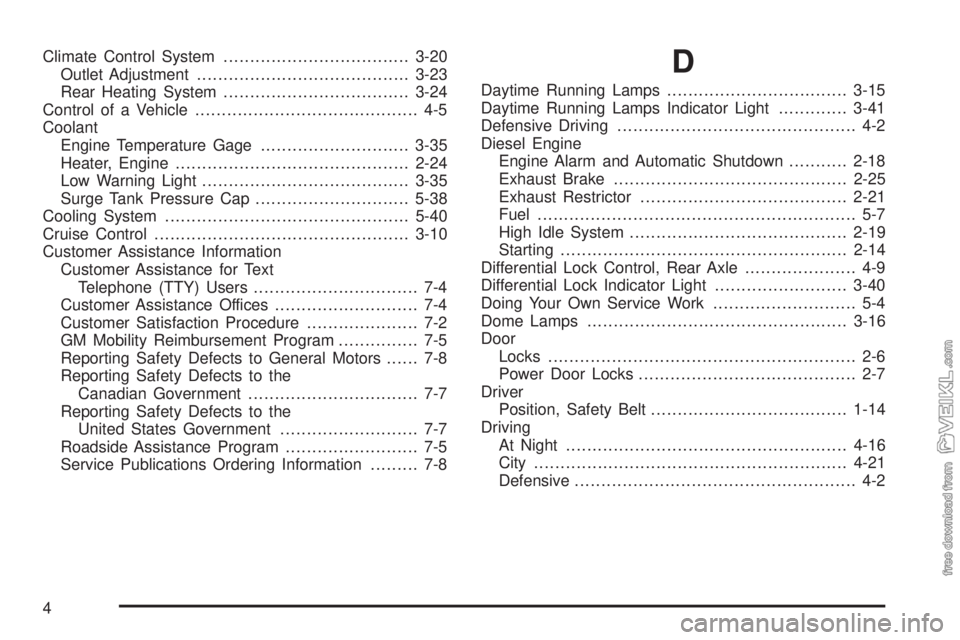
Climate Control System...................................3-20
Outlet Adjustment........................................3-23
Rear Heating System...................................3-24
Control of a Vehicle.......................................... 4-5
Coolant
Engine Temperature Gage............................3-35
Heater, Engine............................................2-24
Low Warning Light.......................................3-35
Surge Tank Pressure Cap.............................5-38
Cooling System..............................................5-40
Cruise Control................................................3-10
Customer Assistance Information
Customer Assistance for Text
Telephone (TTY) Users............................... 7-4
Customer Assistance Offices........................... 7-4
Customer Satisfaction Procedure..................... 7-2
GM Mobility Reimbursement Program............... 7-5
Reporting Safety Defects to General Motors...... 7-8
Reporting Safety Defects to the
Canadian Government................................ 7-7
Reporting Safety Defects to the
United States Government.......................... 7-7
Roadside Assistance Program......................... 7-5
Service Publications Ordering Information......... 7-8D
Daytime Running Lamps..................................3-15
Daytime Running Lamps Indicator Light.............3-41
Defensive Driving............................................. 4-2
Diesel Engine
Engine Alarm and Automatic Shutdown...........2-18
Exhaust Brake............................................2-25
Exhaust Restrictor.......................................2-21
Fuel............................................................ 5-7
High Idle System.........................................2-19
Starting......................................................2-14
Differential Lock Control, Rear Axle..................... 4-9
Differential Lock Indicator Light.........................3-40
Doing Your Own Service Work........................... 5-4
Dome Lamps.................................................3-16
Door
Locks.......................................................... 2-6
Power Door Locks......................................... 2-7
Driver
Position, Safety Belt.....................................1-14
Driving
At Night.....................................................4-16
City...........................................................4-21
Defensive..................................................... 4-2
4